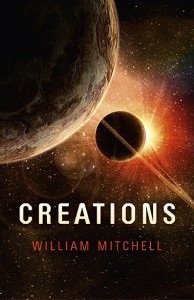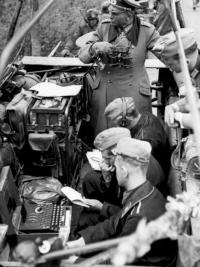
By William Mitchell – Cosmic Egg.
 Near-future SF is a difficult genre in which to write, but one
with a lot of potential and a lot of appeal. For a start it has a sense of immediacy and relevance that far-future SF lacks; it depicts times a reader could imagine living through, and seeing with
their own eyes, even though those events (and the intervening history) are of course entirely fictional. (By comparison far-future SF is set so far beyond any reader's lifetime it might as well be in
another universe.)
Near-future SF is a difficult genre in which to write, but one
with a lot of potential and a lot of appeal. For a start it has a sense of immediacy and relevance that far-future SF lacks; it depicts times a reader could imagine living through, and seeing with
their own eyes, even though those events (and the intervening history) are of course entirely fictional. (By comparison far-future SF is set so far beyond any reader's lifetime it might as well be in
another universe.)
Also, and significantly for a science-fiction perspective, the technological aspects of near-future SF are grounded in a high degree of realism. They describe things which although not part of our current technology, are at least on the horizon, making them plausible in ways which are not true of more fanciful fallbacks such as warp drives and teleportation beams.
And despite the changes in the world, and the advances in technology, the characters are still humans as we would know them: flawed humans making flawed decisions, competing and fighting each other, in the process inciting the events that form the story itself.
Near future SF is not without its problems however. And the biggest one nowadays is the sheer pace of technological advancement which we in the present day are experiencing. It means that by the time a near-future SF book is published, ideas that seemed novel and imaginative when it was written may already be eclipsed by real events or real advancements. The white hot SF idea of 2014 could be yesterday's news by 2017, leaving a book looking quaint and outdated before it has even hit the shelves.
However if the timing is right, and the book is published as the first glimmers of its real-life plausibility are emerging, it can make the book relevant and topical in ways that would be hard to engineer any other way.
My own contribution to near-future SF is "Creations", which will be published under the Cosmic Egg imprint in August 2014. I had the idea for Creations when I first read about the possibility of self-replicating machines, in other words machines which can build copies themselves using raw materials they mine or scavenge from their environment. At face value the idea sounds like those warp drives and teleporters: implausible at best, against the laws of physics at worst. However NASA wouldn't agree; in July 1980 they spent 2 months coming up with concepts for self-replicating lunar factories, intended to strip-mine the entire surface of the Moon in a matter of years with an ever-increasing population of automated factories, starting from a single robotic "seed".
My first thought on hearing the idea was this -- how could you actually design these factories in the first place? What kind of production line would you have to build into them, that can somehow make everything those same machines are built from? At the time (late 1990s) I was working in windtunnel testing, and we had a magical (it seemed then) machine that could make any wing or fuselage model we wanted, almost on a whim, simply by depositing each shape layer by layer. I wondered whether whole mechanisms could be made that way, with electronics and hydraulics and whatever else moulded into them in a single operation, with no limit on complexity or shape or size. Back then our magical device went by the glorious name of a stereolithography machine. Nowadays we know them as 3D printers. And right now it seems that every week or so another news story crops up involving them, and the things they could be used for -- lunar colonies, built automatically in advance of any settlers arriving; 3D printed aircraft and other vehicles; medical applications such as prosthetics and replacement joints; and most intriguingly of all, the "RepRap" program -- the "Replicating Rapid Prototyper", a 3D printer intended for domestic use, but designed from the outset so that it can build the majority of its own parts, and therefore (to a limited extent) "reproduce" its own mechanical offspring. Machine replication via 3D printing, something that in the 1990s I thought was a nice idea to build an SF story round. It means that with Creations, I think I've timed it right -- the world the book is set in is still decades away (2040), but the ideas that led me to write it are just starting to emerge in the real world. As an SF writer, you couldn't ask for more.
As for Creations itself? That stemmed from my second thought on hearing the idea: what if it went wrong? What if this exponentially-growing swarm of autonomous machines stopped doing what their human controllers wanted? What if the equivalence between replicating machines and biological life was taken to its logical conclusion, and evolution took over? Would the result count as a kind of artificial life? And what would that mean for the human race, if what came out of that process was stronger and faster than us? That story, centred on the man coerced into helping build the things but who now has to stop them, is Creations.
BOOK DETAILS
- eBook £4.99 || $7.99
- Aug 29, 2014. 978-1-78279-161-4.
- BUY | AMAZON US | AMAZON UK
- Paperback £11.99 || $20.95
- Aug 29, 2014. 978-1-78279-186-7.
- BUY | AMAZON US | AMAZON UK
Categories:
0 comments on this article







